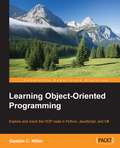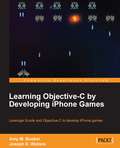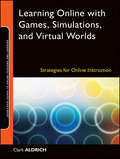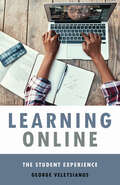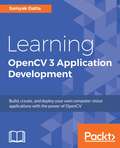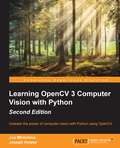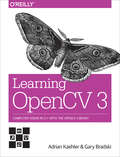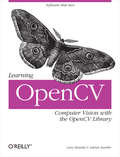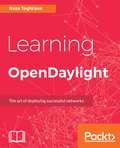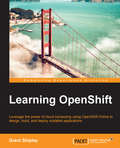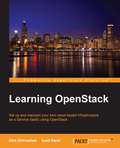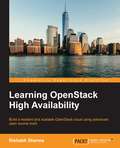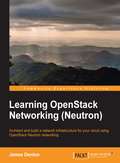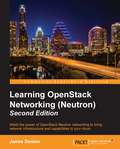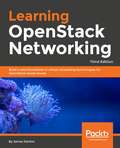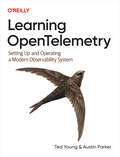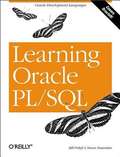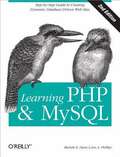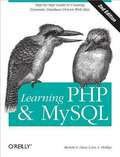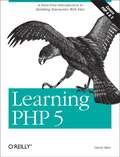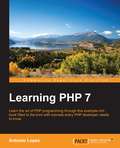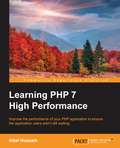- Table View
- List View
Learning Object-Oriented Programming
by Gastón C. HillarIf you're a Python, JavaScript, or C# developer and want to learn the basics of object-oriented programming with real-world examples, then this book is for you.
Learning Objective-C by Developing iPhone Games
by Joseph D. Walters Amy M. BookerWritten as a practical and engaging tutorial, this book guides you through the development of your own exciting, fully featured, games. If you are a beginner and an enthusiast who dreams about creating games and is in need of some additional inspiration and knowledge, then this book is for you. No programming experience is expected.
Learning Online with Games, Simulations, and Virtual Worlds
by Clark AldrichHigher education institutions are increasingly delivering content online, but the content is often not sufficiently engaging. Learning Online with Games, Simulations, and Virtual Worlds provides a simple and practical guide to identifying when and what kind of games, simulations, and virtual environments should be used, how to get them, how to deploy them, and how to measure their effectiveness. Using frameworks, tips, case studies, real examples, and resources, this cutting-edge tool will help faculty members and instructional designers comfortably use games, simulations, and virtual environments to enhance learning.
Learning Online: The Student Experience (Tech.edu: A Hopkins Series on Education and Technology)
by George VeletsianosWhat's it really like to learn online?Learning Online: The Student ExperienceOnline learning is ubiquitous for millions of students worldwide, yet our understanding of student experiences in online learning settings is limited. The geographic distance that separates faculty from students in an online environment is its signature feature, but it is also one that risks widening the gulf between teachers and learners. In Learning Online, George Veletsianos argues that in order to critique, understand, and improve online learning, we must examine it through the lens of student experience.Approaching the topic with stories that elicit empathy, compassion, and care, Veletsianos relays the diverse day-to-day experiences of online learners. Each in-depth chapter follows a single learner's experience while focusing on an important or noteworthy aspect of online learning, tackling everything from demographics, attrition, motivation, and loneliness to cheating, openness, flexibility, social media, and digital divides. Veletsianos also draws on these case studies to offer recommendations for the future and lessons learned. The elusive nature of online learners' experiences, the book reveals, is a problem because it prevents us from doing better: from designing more effective online courses, from making evidence-informed decisions about online education, and from coming to our work with the full sense of empathy that our students deserve. Writing in an evocative, accessible, and concise manner, Veletsianos concretely demonstrates why it is so important to pay closer attention to the stories of students—who may have instructive and insightful ideas about the future of education.
Learning OpenCV 3 Application Development
by Samyak DattaBuild, create, and deploy your own computer vision applications with the power of OpenCV About This Book • This book provides hands-on examples that cover the major features that are part of any important Computer Vision application • It explores important algorithms that allow you to recognize faces, identify objects, extract features from images, help your system make meaningful predictions from visual data, and much more • All the code examples in the book are based on OpenCV 3.1 – the latest version Who This Book Is For This is the perfect book for anyone who wants to dive into the exciting world of image processing and computer vision. This book is aimed at programmers with a working knowledge of C++. Prior knowledge of OpenCV or Computer Vision/Machine Learning is not required. What You Will Learn • Explore the steps involved in building a typical computer vision/machine learning application • Understand the relevance of OpenCV at every stage of building an application • Harness the vast amount of information that lies hidden in images into the apps you build • Incorporate visual information in your apps to create more appealing software • Get acquainted with how large-scale and popular image editing apps such as Instagram work behind the scenes by getting a glimpse of how the image filters in apps can be recreated using simple operations in OpenCV • Appreciate how difficult it is for a computer program to perform tasks that are trivial for human beings • Get to know how to develop applications that perform face detection, gender detection from facial images, and handwritten character (digit) recognition In Detail Computer vision and machine learning concepts are frequently used in practical computer vision based projects. If you're a novice, this book provides the steps to build and deploy an end-to-end application in the domain of computer vision using OpenCV/C++. At the outset, we explain how to install OpenCV and demonstrate how to run some simple programs. You will start with images (the building blocks of image processing applications), and see how they are stored and processed by OpenCV. You'll get comfortable with OpenCV-specific jargon (Mat Point, Scalar, and more), and get to know how to traverse images and perform basic pixel-wise operations. Building upon this, we introduce slightly more advanced image processing concepts such as filtering, thresholding, and edge detection. In the latter parts, the book touches upon more complex and ubiquitous concepts such as face detection (using Haar cascade classifiers), interest point detection algorithms, and feature descriptors. You will now begin to appreciate the true power of the library in how it reduces mathematically non-trivial algorithms to a single line of code! The concluding sections touch upon OpenCV's Machine Learning module. You will witness not only how OpenCV helps you pre-process and extract features from images that are relevant to the problems you are trying to solve, but also how to use Machine Learning algorithms that work on these features to make intelligent predictions from visual data! Style and approach This book takes a very hands-on approach to developing an end-to-end application with OpenCV. To avoid being too theoretical, the description of concepts are accompanied simultaneously by the development of applications. Throughout the course of the book, the projects and practical, real-life examples are explained and developed step by step in sync with the theory.
Learning OpenCV 3 Computer Vision with Python - Second Edition
by Joseph Howse Joe MinichinoUnleash the power of computer vision with Python using OpenCV About This Book * Create impressive applications with OpenCV and Python * Familiarize yourself with advanced machine learning concepts * Harness the power of computer vision with this easy-to-follow guide Who This Book Is For Intended for novices to the world of OpenCV and computer vision, as well as OpenCV veterans that want to learn about what's new in OpenCV 3, this book is useful as a reference for experts and a training manual for beginners, or for anybody who wants to familiarize themselves with the concepts of object classification and detection in simple and understandable terms. Basic knowledge about Python and programming concepts is required, although the book has an easy learning curve both from a theoretical and coding point of view. What You Will Learn * Install and familiarize yourself with OpenCV 3's Python API * Grasp the basics of image processing and video analysis * Identify and recognize objects in images and videos * Detect and recognize faces using OpenCV * Train and use your own object classifiers * Learn about machine learning concepts in a computer vision context * Work with artificial neural networks using OpenCV * Develop your own computer vision real-life application In Detail OpenCV 3 is a state-of-the-art computer vision library that allows a great variety of image and video processing operations. Some of the more spectacular and futuristic features such as face recognition or object tracking are easily achievable with OpenCV 3. Learning the basic concepts behind computer vision algorithms, models, and OpenCV's API will enable the development of all sorts of real-world applications, including security and surveillance. Starting with basic image processing operations, the book will take you through to advanced computer vision concepts. Computer vision is a rapidly evolving science whose applications in the real world are exploding, so this book will appeal to computer vision novices as well as experts of the subject wanting to learn the brand new OpenCV 3.0.0. You will build a theoretical foundation of image processing and video analysis, and progress to the concepts of classification through machine learning, acquiring the technical know-how that will allow you to create and use object detectors and classifiers, and even track objects in movies or video camera feeds. Finally, the journey will end in the world of artificial neural networks, along with the development of a hand-written digits recognition application. Style and approach This book is a comprehensive guide to the brand new OpenCV 3 with Python to develop real-life computer vision applications.
Learning OpenCV 3: Computer Vision in C++ with the OpenCV Library
by Gary Bradski Adrian KaehlerGet started in the rapidly expanding field of computer vision with this practical guide. Written by Adrian Kaehler and Gary Bradski, creator of the open source OpenCV library, this book provides a thorough introduction for developers, academics, roboticists, and hobbyists. You’ll learn what it takes to build applications that enable computers to "see" and make decisions based on that data.With over 500 functions that span many areas in vision, OpenCV is used for commercial applications such as security, medical imaging, pattern and face recognition, robotics, and factory product inspection. This book gives you a firm grounding in computer vision and OpenCV for building simple or sophisticated vision applications. Hands-on exercises in each chapter help you apply what you’ve learned.This volume covers the entire library, in its modern C++ implementation, including machine learning tools for computer vision.Learn OpenCV data types, array types, and array operationsCapture and store still and video images with HighGUITransform images to stretch, shrink, warp, remap, and repairExplore pattern recognition, including face detectionTrack objects and motion through the visual fieldReconstruct 3D images from stereo visionDiscover basic and advanced machine learning techniques in OpenCV
Learning OpenCV 4 Computer Vision with Python 3: Get to grips with tools, techniques, and algorithms for computer vision and machine learning, 3rd Edition
by Joseph Howse Joe MinichinoUpdated for OpenCV 4 and Python 3, this book covers the latest on depth cameras, 3D tracking, augmented reality, and deep neural networks, helping you solve real-world computer vision problems with practical code Key Features Build powerful computer vision applications in concise code with OpenCV 4 and Python 3 Learn the fundamental concepts of image processing, object classification, and 2D and 3D tracking Train, use, and understand machine learning models such as Support Vector Machines (SVMs) and neural networks Book Description Computer vision is a rapidly evolving science, encompassing diverse applications and techniques. This book will not only help those who are getting started with computer vision but also experts in the domain. You'll be able to put theory into practice by building apps with OpenCV 4 and Python 3. You'll start by understanding OpenCV 4 and how to set it up with Python 3 on various platforms. Next, you'll learn how to perform basic operations such as reading, writing, manipulating, and displaying still images, videos, and camera feeds. From taking you through image processing, video analysis, and depth estimation and segmentation, to helping you gain practice by building a GUI app, this book ensures you'll have opportunities for hands-on activities. Next, you'll tackle two popular challenges: face detection and face recognition. You'll also learn about object classification and machine learning concepts, which will enable you to create and use object detectors and classifiers, and even track objects in movies or video camera feed. Later, you'll develop your skills in 3D tracking and augmented reality. Finally, you'll cover ANNs and DNNs, learning how to develop apps for recognizing handwritten digits and classifying a person's gender and age. By the end of this book, you'll have the skills you need to execute real-world computer vision projects. What you will learn Install and familiarize yourself with OpenCV 4's Python 3 bindings Understand image processing and video analysis basics Use a depth camera to distinguish foreground and background regions Detect and identify objects, and track their motion in videos Train and use your own models to match images and classify objects Detect and recognize faces, and classify their gender and age Build an augmented reality application to track an image in 3D Work with machine learning models, including SVMs, artificial neural networks (ANNs), and deep neural networks (DNNs) Who this book is for If you are interested in learning computer vision, machine learning, and OpenCV in the context of practical real-world applications, then this book is for you. This OpenCV book will also be useful for anyone getting started with computer vision as well as experts who want to stay up-to-date with OpenCV 4 and Python 3. Although no prior knowledge of image processing, computer vision or machine learning is required, familiarity with basic Python programming is a must.
Learning OpenCV: Computer Vision with the OpenCV Library
by Gary Bradski Adrian Kaehler"This library is useful for practitioners, and is an excellent tool for those entering the field: it is a set of computer vision algorithms that work as advertised."-William T. Freeman, Computer Science and Artificial Intelligence Laboratory, Massachusetts Institute of Technology Learning OpenCV puts you in the middle of the rapidly expanding field of computer vision. Written by the creators of the free open source OpenCV library, this book introduces you to computer vision and demonstrates how you can quickly build applications that enable computers to "see" and make decisions based on that data. Computer vision is everywhere-in security systems, manufacturing inspection systems, medical image analysis, Unmanned Aerial Vehicles, and more. It stitches Google maps and Google Earth together, checks the pixels on LCD screens, and makes sure the stitches in your shirt are sewn properly. OpenCV provides an easy-to-use computer vision framework and a comprehensive library with more than 500 functions that can run vision code in real time. Learning OpenCV will teach any developer or hobbyist to use the framework quickly with the help of hands-on exercises in each chapter. This book includes:A thorough introduction to OpenCVGetting input from camerasTransforming imagesSegmenting images and shape matchingPattern recognition, including face detectionTracking and motion in 2 and 3 dimensions3D reconstruction from stereo visionMachine learning algorithmsGetting machines to see is a challenging but entertaining goal. Whether you want to build simple or sophisticated vision applications, Learning OpenCV is the book you need to get started.
Learning OpenDaylight
by Reza ToghraeeA practical guide to building programmable networks using OpenDaylight About This Book • Learn and understand how SDN controllers operate and integrate with networks; this book's step-by-step tutorials will give you a strong foundation in SDN, NVF, and OpenDayLight. • Learn how to map legacy Layer 2/3 networking technologies in the SDN world • Add new services and capabilities to your infrastructure and quickly adopt SDN and NFV within your organization with OpenDayLight. • Integrate and manage software-defined networks efficiently in your organization. • Build innovative network applications with OpenDayLight and save time and resources. Who This Book Is For This book targets network engineers, network programmers and developers, administrators, and anyone with some level of networking experience who'd like to deploy OpenDayLight effectively. Familiarity with the day-to-day operations of computer networks is expected What You Will Learn • Transition from legacy networking to software-defined networking • Learn how SDN controllers work and manage a network using southbound and northbound APIs • Learn how to deploy the OpenDayLight SDN controller and integrate it with virtual switches • Understand the basic design and operation of the OpenDaylight platform • Build simple MD-SAL OpenDaylight applications • Build applications on top of OpenDayLight to trigger network changes based on different events • Integrate OpenStack with OpenDayLight to build a fully managed network • Learn how to build a software-defined datacenter using NFV and service-chaining technologies In Detail OpenDaylight is an open source, software-defined network controller based on standard protocols. It aims to accelerate the adoption of Software-Defined Networking (SDN) and create a solid foundation for Network Functions Virtualization (NFV). SDN is a vast subject; many network engineers find it difficult to get started with using and operating different SDN platforms. This book will give you a practical bridge from SDN theory to the practical, real-world use of SDN in datacenters and by cloud providers. The book will help you understand the features and use cases for SDN, NFV, and OpenDaylight. NFV uses virtualization concepts and techniques to create virtual classes for node functions. Used together, SDN and NFV can elevate the standards of your network architecture; generic hardware-saving costs and the advanced and abstracted software will give you the freedom to evolve your network in the future without having to invest more in costly equipment. By the end of this book, you will have learned how to design and deploy OpenDaylight networks and integrate them with physical network switches. You will also have mastered basic network programming over the SDN fabric. Style and approach This is a step-by-step tutorial aimed at getting you up-to-speed with OpenDayLight and ready to adopt it for your SDN (Software-Defined Networking) and NFV (Network Functions Virtualization) ecosystem.
Learning OpenShift
by Grant ShipleyThis book is ideal for you if you're a developer experienced with the PHP or Java programming languages and have a basic understanding of using the command line.
Learning OpenStack
by Alok Shrivastwa Sunil SaratSet up and maintain your own cloud-based Infrastructure as a Service (IaaS) using OpenStack About This Book * Build and manage a cloud environment using just four virtual machines * Get to grips with mandatory as well as optional OpenStack components and know how they work together * Leverage your cloud environment to provide Infrastructure as a Service (IaaS) with this practical, step-by-step guide Who This Book Is For This book is targeted at all aspiring administrators, architects, or students who want to build cloud environments using Openstack. Knowledge of IaaS or cloud computing is recommended. What You Will Learn * Get an introduction to OpenStack and its components * Authenticate and authorize the cloud environment using Keystone * Store and retrieve data and images using storage components such as Cinder, Swift, and Glance * Use Nova to build a Cloud Computing fabric controller * Abstract technology-agnostic networks using the Neutron network component * Gain an understanding of optional components such as Ceilometer, Trove, Ironic, Sahara, Barbican, Zaqar, Designate, Manila, and many more * See how all of the OpenStack components collaborate to provide IaaS to users * Create a production-grade OpenStack and automate your OpenStack Cloud In Detail OpenStack is a free and open source cloud computing platform that is rapidly gaining popularity in Enterprise data centres. It is a scalable operating system and is used to build private and public clouds. It is imperative for all the aspiring cloud administrators to possess OpenStack skills if they want to succeed in the cloud-led IT infrastructure space. This book will help you gain a clearer understanding of OpenStack's components and their interaction with each other to build a cloud environment. You will learn to deploy a self-service based cloud using just four virtual machines and standard networking. You begin with an introduction on the basics of cloud computing. This is followed by a brief look into the need for authentication and authorization, the different aspects of dashboards, cloud computing fabric controllers, along with "Networking as a Service" and "Software Defined Networking." Then, you will focus on installing, configuring, and troubleshooting different architectures such as Keystone, Horizon, Nova, Neutron, Cinder, Swift, and Glance. Furthermore, you will see how all of the OpenStack components come together in providing IaaS to users. Finally, you will take your OpenStack cloud to the next level by integrating it with other IT ecosystem elements before automation. By the end of this book, you will be proficient with the fundamentals and application of OpenStack. Style and approach This is a practical step-by-step guide comprising of installation prerequisites and basic troubleshooting instructions to help you build an error-free OpenStack cloud easily.
Learning OpenStack High Availability
by Rishabh SharmaBuild a resilient and scalable OpenStack cloud, using advanced open source tools About This Book * Leverage the power of OpenStack to achieve high availability * Get to grips with concepts such as Galeria Cluster for Glance and Cinder, MariaDB, and validation * Using clustering and high-availability solutions, this book provides a comprehensive plan for you to connect them with Red Hat Enterprise Linux OpenStack Platform Who This Book Is For This book is for OpenStack administrator, cloud administrator, cloud engineer, or cloud developer with some real time understanding of cloud computing, OpenStack and familiarity with Linux command is essential to start with this book. What You Will Learn * Grasp an understanding of what a highly available design should be using RTO, MTTR, and SLA concepts * Set up and configure Galera and RabbitMQ clusters to build an efficient and reliable messaging cluster * Get to know the advanced areas of network load balancing using configurations of HAproxy and keepalived * Control active/passive OpenStack services by setting up a cluster for two or more nodes * Gain a deeper understanding of how OpenStack services work in cooperation with a stateless mode to offer a scalable cloud framework * Configure and run a distributed neutron installation based on openvswitch and different tunneling protocols * Explore the rudimental configuration of different shared storage options and provide backup services of OpenStack * Get acquainted with how an OpenStack-based cloud can survive various failures using network partitioning split brain, automatic failover, and geo-replication * Distribute applications and services among availability zones in OpenStack to achieve maximum uptime and reliability of service * Control and maintain a cloud with key concepts and tools to correctly measure and control the operations of an OpenStack cloud * Get to know more about the relevant HA deployments of OpenStack with use cases In Detail OpenStack is one of the most popular open source cloud computing platforms, and it is used most of all for deploying Infrastructure as a Service (IaaS) solutions. Enabling high availability in OpenStack is a required skill for cloud administrators and cloud engineers in today's world. This book helps you to achieve high availability and resiliency to OpenStack. This means clustering, fencing, load-balancing, distributed networking, leveraging shared storage, automatic failover, and replication. We start with a basic understanding of what a highly available design is meant to achieve in OpenStack and various ways to achieve high availability in OpenStack through simple step-by-step procedures. Through hands-on examples, you will develop a solid knowledge of horizontally-scalable, fault-resistant, and highly-available OpenStack clusters and will be able to apply the techniques from this book in your day-to-day projects. This book also sheds light on the principles of application design for high availability, and monitoring for high availability, with examples. Style and approach This is a step-by-step guide that uses clustering and high-availability solutions available in the market and provides a comprehensive plan to connect them with Red Hat Enterprise Linux OpenStack Platform to make you a competent OpenStack administrator.
Learning OpenStack Networking (Neutron)
by James DentonIf you are an OpenStack-based cloud operator with experience in OpenStack Compute and nova-network but are new to Neutron networking, then this book is for you. Some networking experience is recommended, and a physical network infrastructure is required to provide connectivity to instances and other network resources configured in the book.
Learning OpenStack Networking (Neutron) - Second Edition
by James DentonIf you are an OpenStack-based cloud operator and administrator who is new to Neutron networking and wants to build your very own OpenStack cloud, then this book is for you. Prior networking experience and a physical server and network infrastructure is recommended to follow along with concepts demonstrated in the book.
Learning OpenStack Networking: Build a solid foundation in virtual networking technologies for OpenStack-based clouds, 3rd Edition
by James DentonDiscover the basics of virtual networking in OpenStack to implement various cloud network architecturesKey FeaturesLearn the difference between Open vSwitch and Linux bridge switching technologiesConnect virtual machine instances to virtual networks, subnets, and portsImplement virtual load balancers, firewalls, and routers in your networkBook DescriptionOpenStack Networking is a pluggable, scalable, and API-driven system to manage physical and virtual networking resources in an OpenStack-based cloud. Like other core OpenStack components, OpenStack Networking can be used by administrators and users to increase the value and maximize the use of existing datacenter resources. This third edition of Learning OpenStack Networking walks you through the installation of OpenStack and provides you with a foundation that can be used to build a scalable and production-ready OpenStack cloud.In the initial chapters, you will review the physical network requirements and architectures necessary for an OpenStack environment that provide core cloud functionality. Then, you’ll move through the installation of the new release of OpenStack using packages from the Ubuntu repository. An overview of Neutron networking foundational concepts, including networks, subnets, and ports will segue into advanced topics such as security groups, distributed virtual routers, virtual load balancers, and VLAN tagging within instances.By the end of this book, you will have built a network infrastructure for your cloud using OpenStack Neutron.What you will learnGet familiar with Neutron constructs, including agents and pluginsBuild foundational Neutron resources to provide connectivity to instancesWork with legacy Neutron routers and troubleshoot traffic through themExplore high-availability routing capabilities utilizing Virtual Router Redundancy Protocol (VRRP)Create and manage load balancers and associated componentsManage security groups as a method of securing traffic to and from instancesWho this book is forIf you are an OpenStack-based cloud operator and administrator who is new to Neutron networking and wants to build your very own OpenStack cloud, then this book is for you.Prior networking experience and a physical server and network infrastructure is recommended to follow along with concepts demonstrated in the book.
Learning OpenTelemetry: Setting Up and Operating a Modern Observability System
by Austin Parker Ted YoungOpenTelemetry is a revolution in observability data. Instead of running multiple uncoordinated pipelines, OpenTelemetry provides users with a single integrated stream of data, providing multiple sources of high-quality telemetry data: tracing, metrics, logs, RUM, eBPF, and more. This practical guide shows you how to set up, operate, and troubleshoot the OpenTelemetry observability system.Authors Austin Parker, head of developer relations at Lightstep and OpenTelemetry Community Maintainer, and Ted Young, cofounder of the OpenTelemetry project, cover every OpenTelemetry component, as well as observability best practices for many popular cloud, platform, and data services such as Kubernetes and AWS Lambda. You'll learn how OpenTelemetry enables OSS libraries and services to provide their own native instrumentation—a first in the industry.Ideal for application developers, OSS maintainers, operators and infrastructure teams, and managers and team leaders, this book guides you through:The principles of modern observabilityAll OpenTelemetry components—and how they fit togetherA practical approach to instrumenting platforms and applicationsMethods for installing, operating, and troubleshooting an OpenTelemetry-based observability solutionWays to roll out and maintain end-to-end observability across a large organizationHow to write and maintain consistent, high-quality instrumentation without a lot of work
Learning Oracle PL/SQL
by Bill PribylDesigned for both new programmers and those experienced in other languages, this book presents the core features of Oracle's PL/SQL language in an easy-to-read format. Learning Oracle PL/SQL will bring programmers up to speed on the most important aspects of PL/SQL, including web and Internet programming. Updated through Oracle9i, includes sample programs downloadable from examples.oreilly.com/learnoracle .
Learning Oracle PL/SQL
by Bill PribylPL/SQL, Oracle's programming language for stored procedures, delivers a world of possibilities for your database programs. PL/SQL supplements the standard relational database language, SQL, with a wide range of procedural features, including loops, IF-THEN statements, advanced data structures, and rich transactional control--all closely integrated with the Oracle database server. Knowing where to start with Oracle's procedural language is not always obvious to a newcomer, especially considering the language's feature set and the sheer size of the official documentation (not to mention Oracle's ever-increasing number of pre-built PL/SQL programs). But Learning Oracle PL/SQL offers the signposts and guidance you need to come up to speed on the language, delivered in a manageable number of pages while covering all the essentials. Topics include: PL/SQL--what is it, and why use it? Why use PL/SQL instead of Java? Syntax and examples of all core language constructs Creating, using, and reusing stored procedures, functions, and packages Building web-based applications using PL/SQL features available "out of the box" (such as PL/SQL Server Pages) Securing PL/SQL programs against attack Benefits of third-party developer tools and integrated development environments Connecting PL/SQL to email, Java, and the Internet Meticulously crafted with all-new examples downloadable from examples.oreilly.com/learnoracle , the book addresses language features available in all versions of Oracle, from Oracle7 to Oracle8i to Oracle9i. Learning Oracle PL/SQL was written by PL/SQL experts Bill Pribyl and Steven Feuerstein, whose easy-to-read style and attention to detail has made other O'Reilly books (such as the bestselling Oracle PL/SQL Programming ) very popular among Oracle developers worldwide. Learning Oracle PL/SQL is meant for a wide range of target audiences, including both beginning programmers and those already experienced with other programming languages. Whether you are a new developer, a crossover programmer from another database system, or a new database administrator who needs to learn PL/SQL, this book will get you well on your way. It is the perfect introduction to Oracle PL/SQL Programming , also by Pribyl and Feuerstein.
Learning PHP & MySQL
by Michele E. Davis Jon A. PhillipsPHP and MySQL are quickly becoming the de facto standard for rapid development of dynamic, database-driven web sites. This book is perfect for newcomers to programming as well as hobbyists who are intimidated by harder-to-follow books. With concepts explained in plain English, the new edition starts with the basics of the PHP language, and explains how to work with MySQL, the popular open source database. You then learn how to put the two together to generate dynamic content. If you come from a web design or graphics design background and know your way around HTML, Learning PHP & MySQL is the book you've been looking for. The content includes: PHP basics such as strings and arrays, and pattern matching A detailed discussion of the variances in different PHP versions MySQL data fundamentals like tables and statements Information on SQL data access for language A new chapter on XHTML Error handling, security, HTTP authentication, and more Learning PHP & MySQL explains everything from fundamental concepts to the nuts and bolts of performing specific tasks. As part of O'Reilly's bestselling Learning series, the book is an easy-to-use resource designed specifically for beginners. It's a launching pad for future learning, providing you with a solid foundation for more advanced development.
Learning PHP & MySQL, 2nd Edition
by Michele E. Davis Jon A. PhillipsAssuming a familiarity with HTML, this guide shows how to create dynamic web sites with the Apache web server, PHP server-side programming language, and MySQL database. The authors explain PHP functions and arrays, SQL commands, forms, the Pear collection of reusable PHP components, string manipulation, cookies and sessions, access control, web site security, data validation, and an example blog application. Annotation ©2006 Book News, Inc. , Portland, OR (booknews. com)
Learning PHP & MySQL, 2nd Edition
by Michele Weiner Davis Jon PhillipsPHP and MySQL are quickly becoming the de facto standard for rapid development of dynamic, database-driven web sites. This book is perfect for newcomers to programming as well as hobbyists who are intimidated by harder-to-follow books. With concepts explained in plain English, the new edition starts with the basics of the PHP language, and explains how to work with MySQL, the popular open source database. You then learn how to put the two together to generate dynamic content. If you come from a web design or graphics design background and know your way around HTML, Learning PHP & MySQL is the book you've been looking for. The content includes: *PHP basics such as strings and arrays, and pattern matching *A detailed discussion of the variances in different PHP versions *MySQL data fundamentals like tables and statements *Information on SQL data access for language *A new chapter on XHTML *Error handling, security, HTTP authentication, and more. Learning PHP & MySQL explains everything from fundamental concepts to the nuts and bolts of performing specific tasks. As part of O'Reilly's bestselling Learning series, the book is an easy-to-use resource designed specifically for beginners. It's a launching pad for future learning, providing you with a solid foundation for more advanced development.
Learning PHP 5
by David SklarPHP has gained a following among non-technical web designers who need to add interactive aspects to their sites. Offering a gentle learning curve, PHP is an accessible yet powerful language for creating dynamic web pages. As its popularity has grown, PHP's basic feature set has become increasingly more sophisticated. Now PHP 5 boasts advanced features--such as new object-oriented capabilities and support for XML and Web Services--that will please even the most experienced web professionals while still remaining user-friendly enough for those with a lower tolerance for technical jargon. If you've wanted to try your hand at PHP but haven't known where to start, then Learning PHP 5 is the book you need. If you've wanted to try your hand at PHP but haven't known where to start, then Learning PHP 5 is the book you need. With attention to both PHP 4 and the new PHP version 5, it provides everything from a explanation of how PHP works with your web server and web browser to the ins and outs of working with databases and HTML forms. Written by the co-author of the popular PHP Cookbook, this book is for intelligent (but not necessarily highly-technical) readers. Learning PHP 5 guides you through every aspect of the language you'll need to master for professional web programming results. This book provides a hands-on learning experience complete with exercises to make sure the lessons stick. Learning PHP 5 covers the following topics, and more:How PHP works with your web browser and web server PHP language basics, including data, variables, logic and looping Working with arrays and functions Making web forms Working with databases like MySQL Remembering users with sessions Parsing and generating XML Debugging Written by David Sklar, coauthor of the PHP Cookbook and an instructor in PHP, this book offers the ideal classroom learning experience whether you're in a classroom or on your own. From learning how to install PHP to designing database-backed web applications, Learning PHP 5 will guide you through every aspect of the language you'll need to master to achieve professional web programming results.
Learning PHP 7
by Antonio LopezLearn the art of PHP programming through this example-rich book filled to the brim with tutorials every PHP developer needs to know About This Book * Set up the PHP environment and get started with web programming * Leverage the potential of PHP for server-side programming, memory management, and object-oriented programming (OOP) * This book is packed with real-life examples to help you implement the concepts as you learn Who This Book Is For If you are a web developer or programmer who wants to create real-life web applications using PHP 7, or a beginner who wants to get started with PHP 7 programming, this book is for you. Prior knowledge of PHP, PHP 7, or programming is not mandatory. What You Will Learn * Set up a server on your machine with PHP * Use PHP syntax with the built-in server to create apps * Apply the OOP paradigm to PHP to write richer code * Use MySQL to manage data in your web applications * Create a web application from scratch using MVC * Add tests to your web application and write testable code * Use an existing PHP framework to build and manage your applications * Build REST APIs for your PHP applications * Test the behavior of web applications with Behat In Detail PHP is a great language for building web applications. It is essentially a server-side scripting language that is also used for general purpose programming. PHP 7 is the latest version with a host of new features, and it provides major backwards-compatibility breaks. This book begins with the fundamentals of PHP programming by covering the basic concepts such as variables, functions, class, and objects. You will set up PHP server on your machine and learn to read and write procedural PHP code. After getting an understanding of OOP as a paradigm, you will execute MySQL queries on your database. Moving on, you will find out how to use MVC to create applications from scratch and add tests. Then, you will build REST APIs and perform behavioral tests on your applications. By the end of the book, you will have the skills required to read and write files, debug, test, and work with MySQL. Style and approach This book begins with the basics that all PHP developers use every day and then dives deep into detailed concepts and tricks to help you speed through development. You will be able to learn the concepts by performing practical tasks and implementing them in your daily activities, all at your own pace.
Learning PHP 7 High Performance
by Altaf HussainImprove the performance of your PHP application to ensure the application users aren't left waiting About This Book * Make the optimum use of PHP coding to improve your programming productivity * Leverage the potential of PHP for server-side programming, memory management, and object-oriented programming * Packed with real-life examples to help the readers implement concepts as they learn Who This Book Is For This book is for those who have basic experience in PHP programming. If you are developing performance-critical applications, then this book is for you. What You Will Learn * Setup high performance development and production environment for PHP 7 * Discover new OOP features in PHP 7 to achieve high performance * Improve your PHP applications' performance * Attain improved database performance * Benchmark PHP applications to optimize them * Write quality code by learning to improve code reusability, simplicity, and expressiveness * Get rid of the bottlenecks in your PHP 7 applications by writing PHP code optimally * Tackle issues related to web applications, such as high user dependency and large datasets In Detail PHP is a great language for building web applications. It is essentially a server-side scripting language that is also used for general-purpose programming. PHP 7 is the latest version, providing major backward-compatibility breaks and focusing on high performance and speed. This fast-paced introduction to PHP 7 will improve your productivity and coding skills. The concepts covered will allow you, as a PHP programmer, to improve the performance standards of your applications. We will introduce you to the new features in PHP 7 and then will run through the concepts of object-oriented programming (OOP) in PHP 7. Next, we will shed some light on how to improve your PHP 7 applications' performance and database performance. Through this book, you will be able to improve the performance of your programs using the various benchmarking tools discussed. At the end, the book discusses some best practices in PHP programming to help you improve the quality of your code. Style and approach The book is a step-by-step guide to improve the quality of your code in PHP through real-time examples. The book takes a practical approach to improving the quality of your code.
